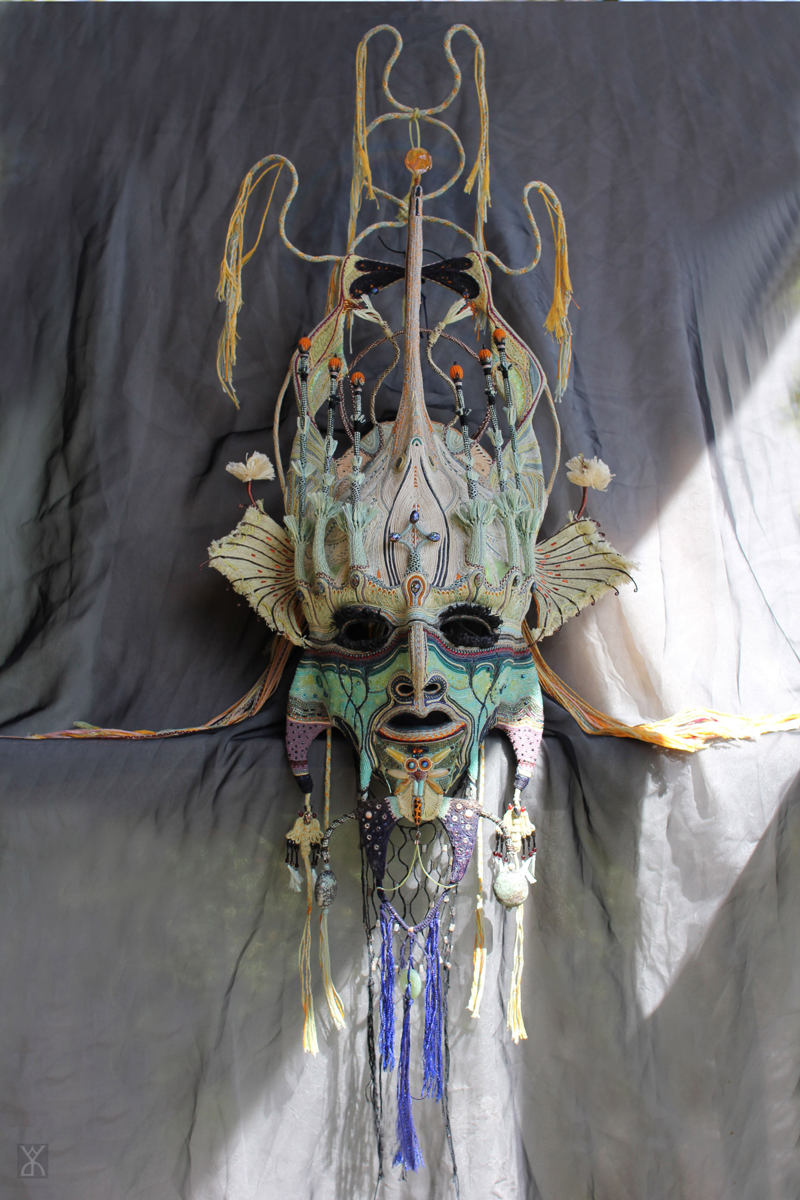Wherein photos of “Quiet Water – A Wetlands Mask”
will appear as visual aids — from initial sketches to final result.
For me, a new mask begins with a strong pull from a particular natural habitat. I’ll revisit that habitat if I can. If not, I’ll resort to memory. I think about the animals and plants I most strongly associate with it — its geology and weather, and its human history, too. And I’ll draw upon other people’s biological, environmental, philosophical, and poetic works — anything I can read or view to deepen my understanding.
It’s not possible to include every entity of a habitat in one mask, and yet it might be possible to give some hint of respect to many of them. How to render the fullest vision of any vital spot on Earth in the form of a human-derived mask? That is where the test lies for me. To rise to this call is not like accepting an invitation to a picnic, but it is enthralling, and has propelled me on a weird and wonderful journey closer to somewhere.
My initial vision of the mask appears as a  journal sketch with notes about the natural forms and their textures. In the case of the wetlands mask, I was thinking of the Great Blue Heron, mosquito, willow branches and roots, dragonfly nymph, horsetails, stonefly, tadpole, silt… . I add color pencil swatches for the array of hues I feel are most kin to the habitat.
journal sketch with notes about the natural forms and their textures. In the case of the wetlands mask, I was thinking of the Great Blue Heron, mosquito, willow branches and roots, dragonfly nymph, horsetails, stonefly, tadpole, silt… . I add color pencil swatches for the array of hues I feel are most kin to the habitat.
I sleep on these initial notions hoping my dreams will show me how to weave all of the elements into a pleasing whole, and perhaps even suggest what the name of the mask should be. I modify my rough sketches, adding more notes with arrows pointing to various places on the mask. I include notes on techniques I might need to use. I also begin writing a short story, a sort of prose poem about the mask, focusing on its underlying meaning.
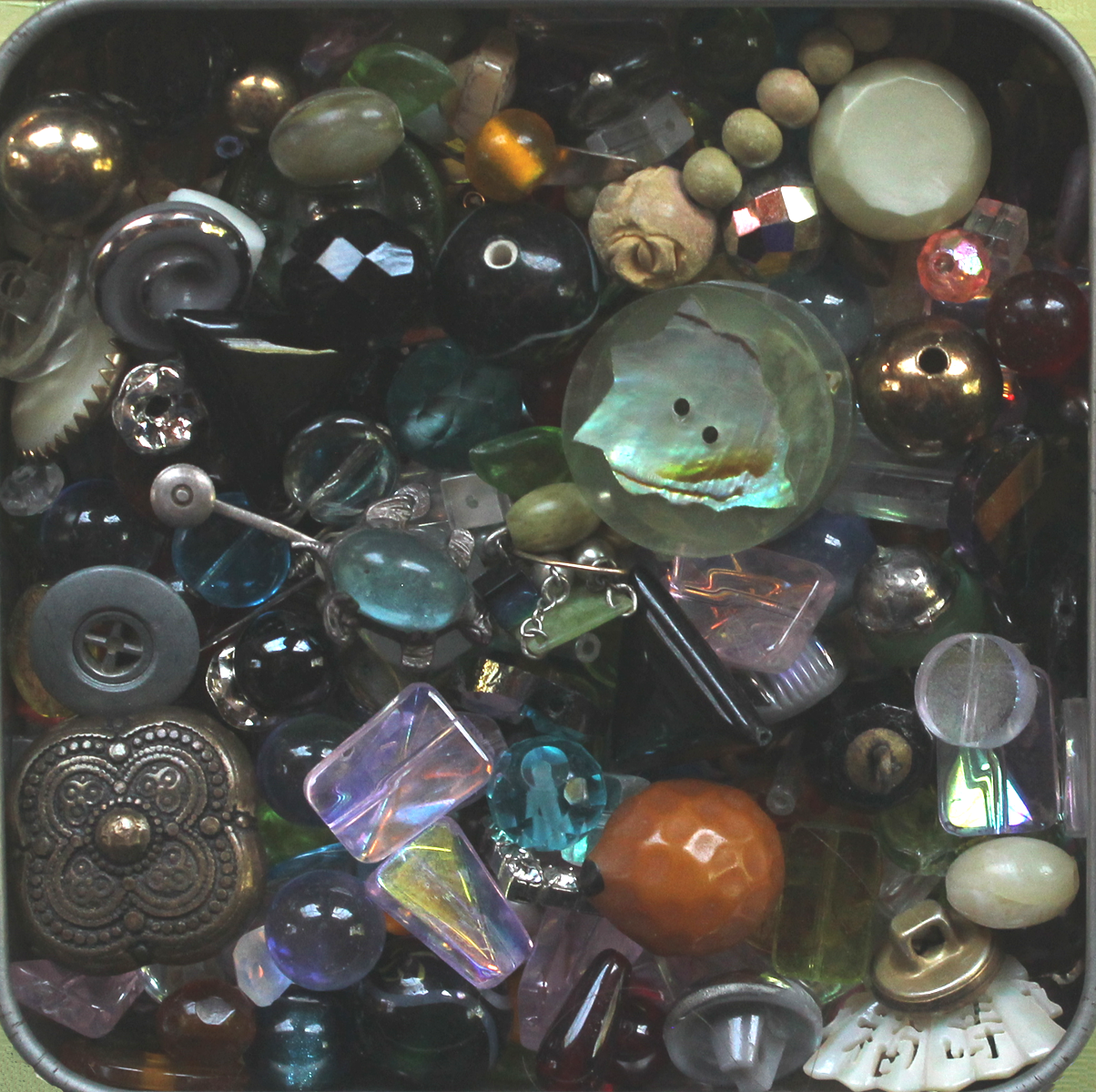 All the while I’m dreaming about this mask-to-be, I’m searching for materials to fit the emerging/evolving vision. I tell friends what I’m up to and sometimes they bring offerings to the cause. I sort through all the possibilities — both natural and manmade found objects, plus store-bought beads and fibers. I arrange and rearrange all this stuff, and kept it on display so I can check in on it as I go about my daily chores. So many natural materials, such as leaves, which I wish I could include in a mask would be much too fragile — they would be returning to nature even before I completed the mask! So I imagine how I’ll insinuate these elements using longer-lasting manmade materials.
All the while I’m dreaming about this mask-to-be, I’m searching for materials to fit the emerging/evolving vision. I tell friends what I’m up to and sometimes they bring offerings to the cause. I sort through all the possibilities — both natural and manmade found objects, plus store-bought beads and fibers. I arrange and rearrange all this stuff, and kept it on display so I can check in on it as I go about my daily chores. So many natural materials, such as leaves, which I wish I could include in a mask would be much too fragile — they would be returning to nature even before I completed the mask! So I imagine how I’ll insinuate these elements using longer-lasting manmade materials.
Note: I see there are an astounding amount of ‘I’s in this discussion so far, especially considering the masks feel like an assignment I’ve been given from a realm of consciousness beyond my knowing. But what can ‘I’ do? To simplify this exposé I need to act as though I’m the primary operator when actually I’m the worker striving to find ways to make each mask, and now, to explain the process of making them. I tell you, it’s like trying to translate a dream into a written story while pretending I am the inventor of Dreaming — which I know I’m not. This said, I’ll continue on in the same vein.
 Finally I take the leap into the work itself and find myself standing in front of a mirror holding a loop of armature wire around the perimeter of my own face (as a matter of convenience.) And with needle-nosed pliers in my other hand, I cinch the measurement. Keeping an eye on bilateral symmetry, I bend and curve a length of wire vertically over the median of my forehead, brow, nose, lips and chin, and cinch that, too, at the top and the bottom. (Have you ever noticed how the profile of a human face looks like the trajectory for a child’s rollercoaster ride? Exhilarating without being too traumatic.) Then come two horizontal wires — across the brow and cheek bones. They will designate the whereabouts of the eye holes. I add more armature wire to define those two openings, and for the mouth and nostrils as well. You’ll be hard put to find anything resembling human ears, but they will appear in some form at some point. (Otherwise how would the mask be able to hear all the questions we’re going to ask of it?) Everything from here on out is an imaginative blending of the human face/head with other elements of a natural habitat. I’m no longer using my own face as a gauge, and can now breathe a sigh of relief.
Finally I take the leap into the work itself and find myself standing in front of a mirror holding a loop of armature wire around the perimeter of my own face (as a matter of convenience.) And with needle-nosed pliers in my other hand, I cinch the measurement. Keeping an eye on bilateral symmetry, I bend and curve a length of wire vertically over the median of my forehead, brow, nose, lips and chin, and cinch that, too, at the top and the bottom. (Have you ever noticed how the profile of a human face looks like the trajectory for a child’s rollercoaster ride? Exhilarating without being too traumatic.) Then come two horizontal wires — across the brow and cheek bones. They will designate the whereabouts of the eye holes. I add more armature wire to define those two openings, and for the mouth and nostrils as well. You’ll be hard put to find anything resembling human ears, but they will appear in some form at some point. (Otherwise how would the mask be able to hear all the questions we’re going to ask of it?) Everything from here on out is an imaginative blending of the human face/head with other elements of a natural habitat. I’m no longer using my own face as a gauge, and can now breathe a sigh of relief.
Referring to my journal sketches, I add more armature wire for the special elements — depending on the the habitat — wings, fins, horns, beaks, antennae, branches,… .
Next, I cover the face, and also other areas I conceive of as more solid, with an easily cuttable, bendable, somewhat stretchable, fine wire mesh — curling it and then sewing it around the armature wire with a ‘thread’ of fine wire.
I live with this wire sculpture for awhile (which looks to me like a wire version of some insect humans extincted before they’d ever laid eyes on it.) I regard its proportions, its balance, while imagining its future. As with Quiet Water — A Wetlands Mask (portrayed here), I lived with it for at least six years, sleeping on it a lot. The process of making a mask takes untold hours of sleep — with the hope of netting useful dreams, as well as recuperating from the stress of not working on the mask. After about four years, friends started saying something like, That’s an interesting looking wire sculpture. (Some of them might have been wondering what became of their emotional investment of mask stuff.)
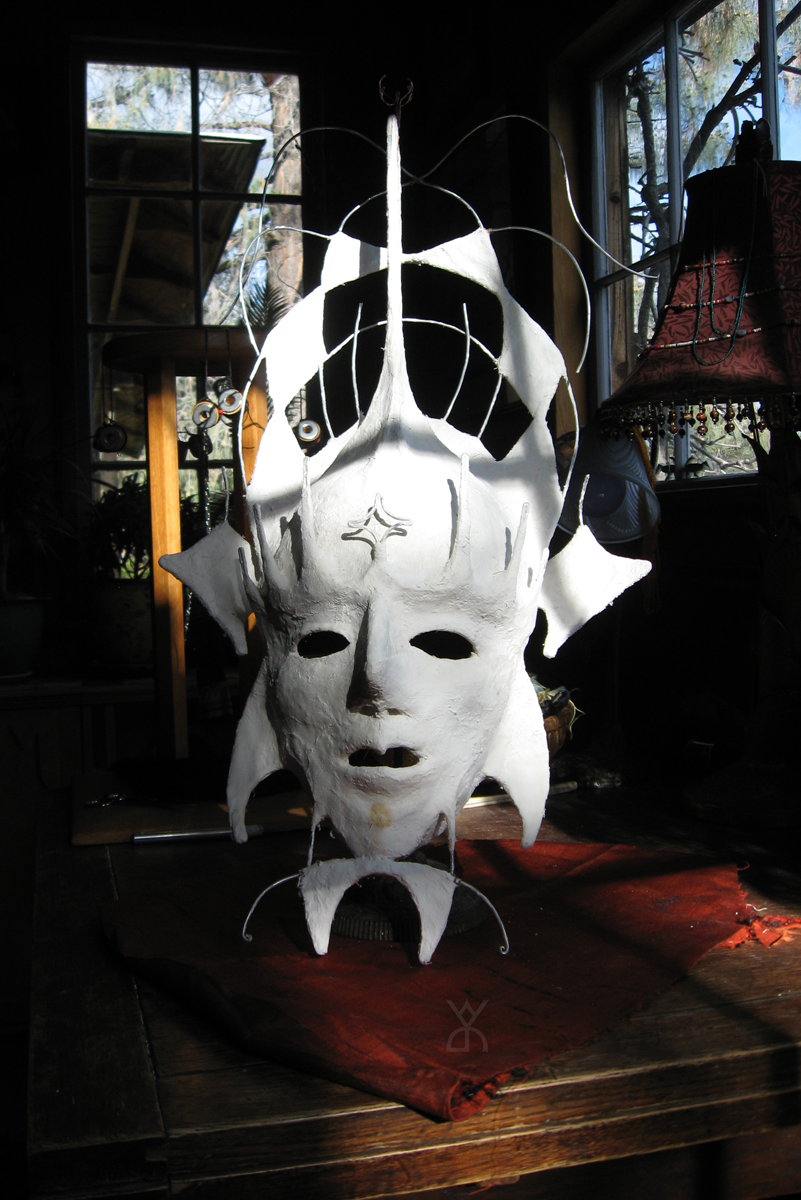 Eventually there comes a day when the season feels right, or some disaster, such as The Gulf Oil Disaster, and/or The Fukushima Nuclear Disaster, jars me into action. Suddenly the mask looks naked, vulnerable. I start applying plaster gauze over the wire mesh — both front and back, like there’s no time like now.
Eventually there comes a day when the season feels right, or some disaster, such as The Gulf Oil Disaster, and/or The Fukushima Nuclear Disaster, jars me into action. Suddenly the mask looks naked, vulnerable. I start applying plaster gauze over the wire mesh — both front and back, like there’s no time like now.
I like using plaster gauze because I can begin by molding it as though it were clay and end up carving it as though it were stone. It’s quite accepting of any inspiration it will be subjected to from here on out.
Sometimes I also do paper engineering — cutting heavy-ply, cotton rag watercolor paper into the desired shapes, soaking them in water and bending them into 3-dimensional forms, fastening them with clothes pins and rubber bands until they dry in place. Then laying down plaster gauze patches, all over, around and under. Merging these shapes with the existing wire mesh and armature wire. Then I carve, sand. Sand, carve. Sand until the mask is as smooth and as white as a sun bleached human skull.
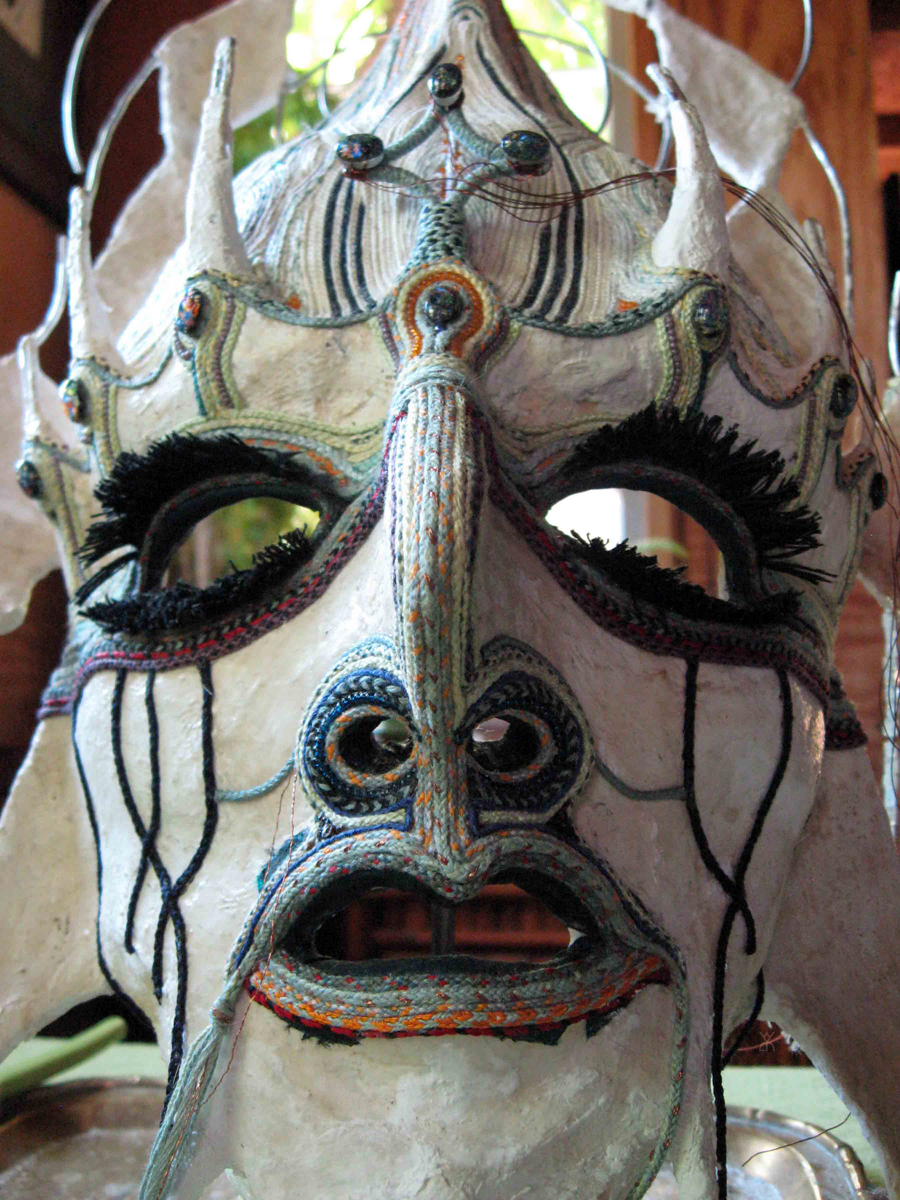
Then it’s ready to receive the embellishments — the longest phase of the creation. I learn or invent new techniques as I go, whatever is needed to accomplish the vision — such as soldering wire for wings, mounting molted reptile skin, or whittling abalone, urchin, or duck egg shell. It’s a process of discovery, full of false starts, and new turns.
When embellishing the surface of a mask I always begin with the eyes. When the eyes are defined, the mask starts giving me the eye. It watches me watching it. It’s impossible to ignore it now.
The next feature I work on after the eyes, is the mouth, with the nose coming into its own somewhere in between. Now the mask can breathe, and speak, and it starts telling me what it wants. It might even tell me what sort of gender it is and whether it’s a youth or an elder, or anything in between any of these. Now I get to jive what it tells me with what my dreams have been telling me. It can be confusing, but no less enthralling.
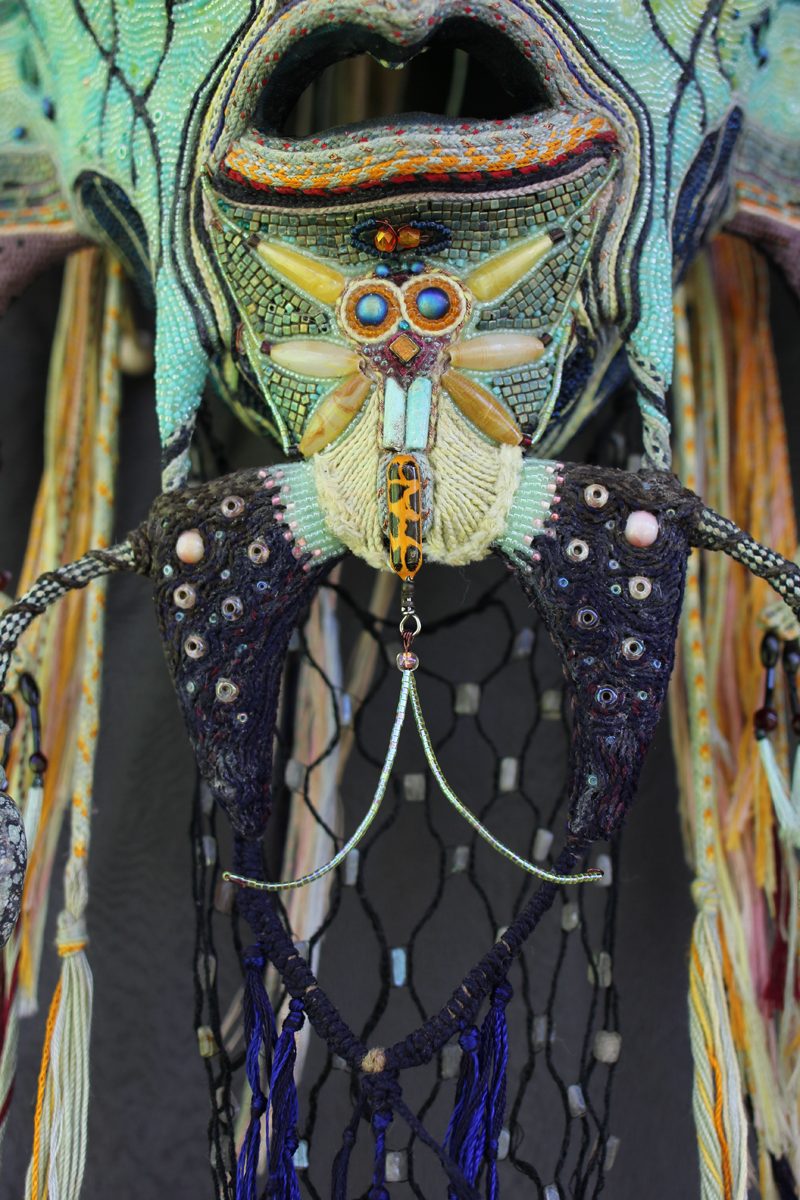 I continue to check in with my journal for a while, but inevitably a mask takes off on its own course. After that, the journal sketches look, well, rather sketchy and inadequate. I’m relieved to see that the mask itself is fairing much better. I become enamored of it. Actually it beckons to me constantly, and occasionally it appears in my dreams as a living creature! I’m willing to do nearly anything it asks me to do to it. If I can. I’ll even invent new techniques in order to make it what it wants to be. One thing it never asks of me is to work faster. It just wants total and careful attention. Yes, much like a newborn human. Yet, it also has this other, more-than-itself aura about it — something to do with its concern for the Earth it will soon be inhabiting.
I continue to check in with my journal for a while, but inevitably a mask takes off on its own course. After that, the journal sketches look, well, rather sketchy and inadequate. I’m relieved to see that the mask itself is fairing much better. I become enamored of it. Actually it beckons to me constantly, and occasionally it appears in my dreams as a living creature! I’m willing to do nearly anything it asks me to do to it. If I can. I’ll even invent new techniques in order to make it what it wants to be. One thing it never asks of me is to work faster. It just wants total and careful attention. Yes, much like a newborn human. Yet, it also has this other, more-than-itself aura about it — something to do with its concern for the Earth it will soon be inhabiting.
Even though the masks are not intended to actually be worn, they are created as though they could be. I feel this enhances our imagination when looking at the masks — to be able to imagine putting them on. And so they are created to fit the human face, and the insides are lined with fabrics that reflect the habitat of its outward face. And, the final touch — tie cords at its temples.
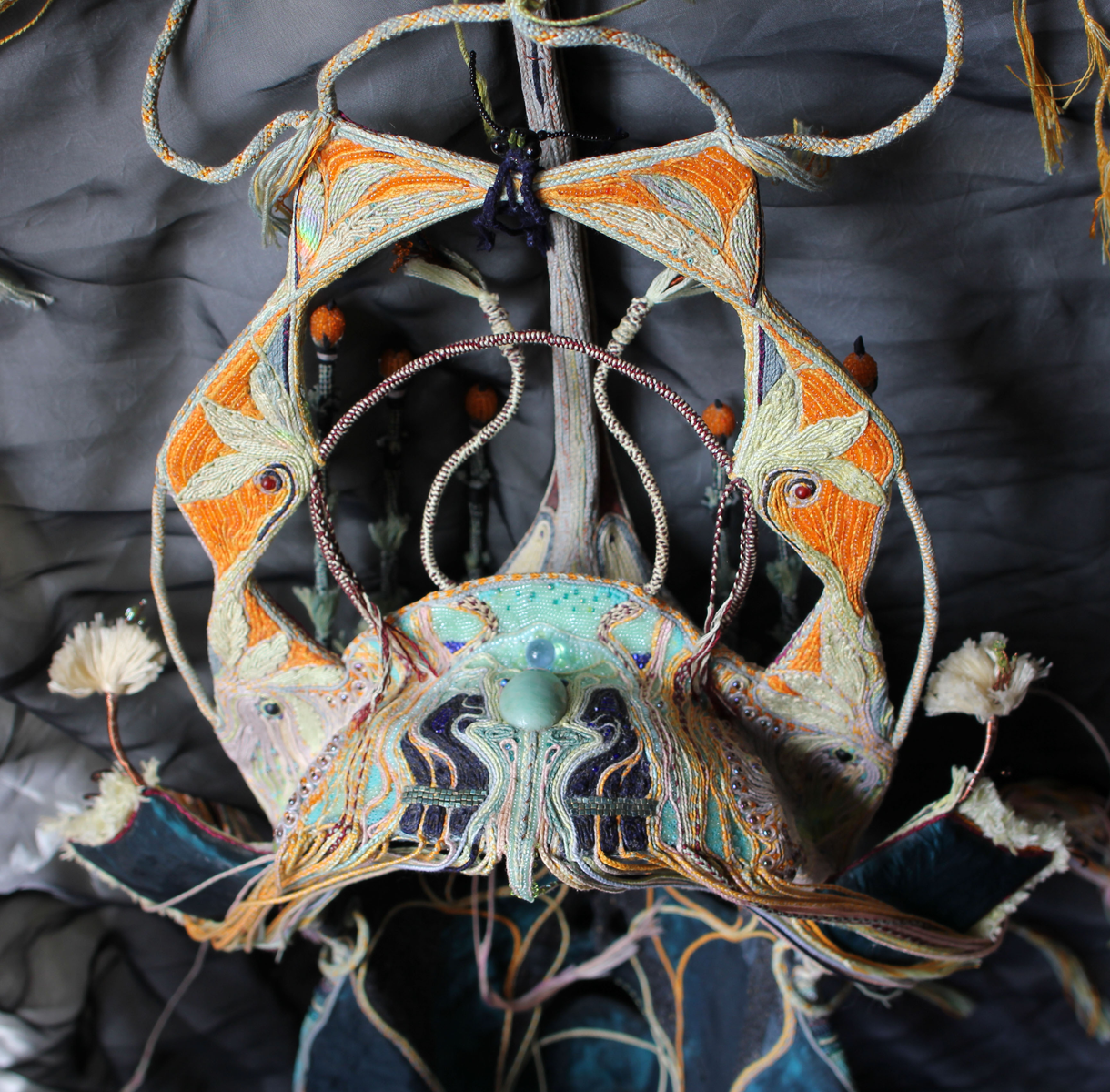
One thing I’ve come to rely on throughout the entire making of a mask, is braiding. I braid, upon demand, various kinds of fibers — raffia, hemp, cotton, rayon, silk — many simple three-stranded braids. But also more elaborate ones, where 8 or 16 strands are generated on a marudai, a circular Japanese braiding loom — using an ancient technique called, Kumihimo. I learned all I needed to know for my purposes from a book titled Kumihimo, Japanese Silk Braiding Techniques, by Catherine Martin, published by Lark Books. My former husband, Vladimir, built a loom for me based on the dimensions given in this book. Braiding in this way is a form of meditation which has taken my mask-making experience into a daylight realm of quiet revelation.
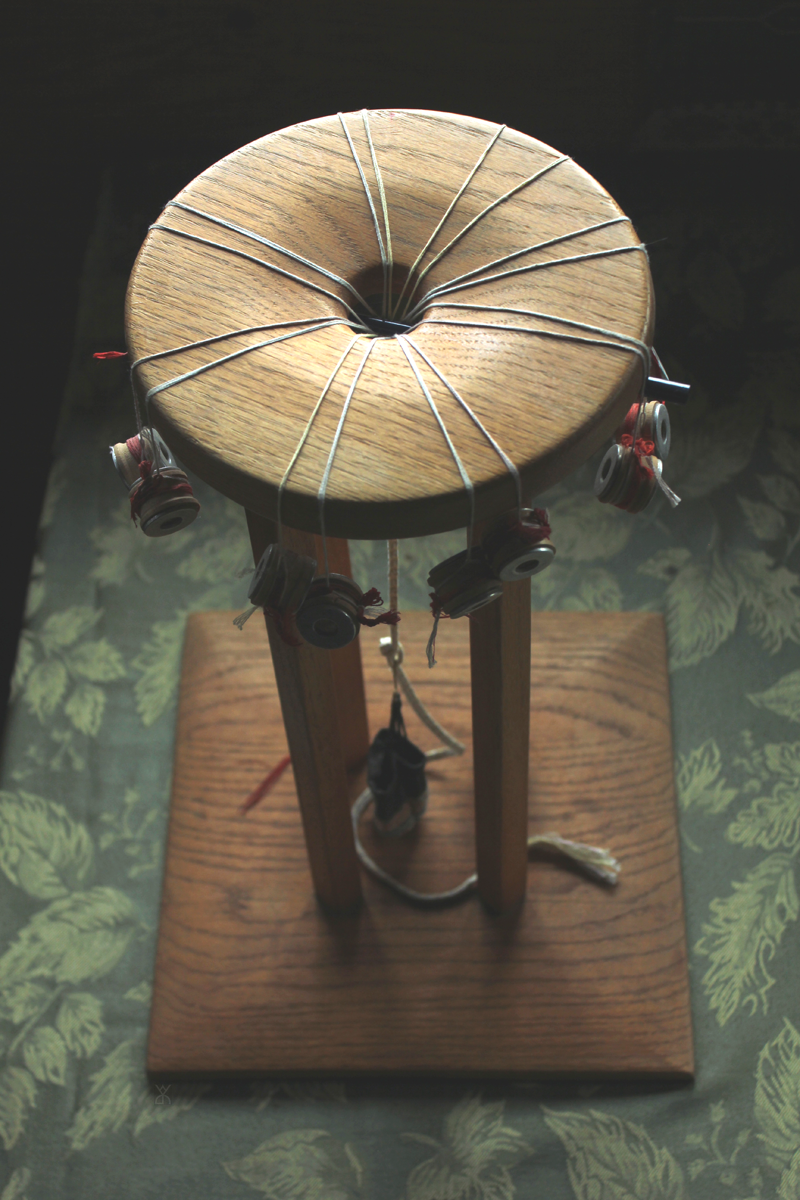 And if that wasn’t enough, my daughter gifted me with an instructional book on ornamental knot tying — Decorative Fusion Knots, by JD Lenzen. It’s like dreaming you’ve discovered a new room in your house. There is no excuse for not subjecting the braids I’ve learned how to braid on the marudai to the knots I’ve learned how to tie. Endless possibilities! The masks will not be wanting. Anything can be accomplished with good intentions, ample inspiration, gratitude, perseverance, and enough time.
And if that wasn’t enough, my daughter gifted me with an instructional book on ornamental knot tying — Decorative Fusion Knots, by JD Lenzen. It’s like dreaming you’ve discovered a new room in your house. There is no excuse for not subjecting the braids I’ve learned how to braid on the marudai to the knots I’ve learned how to tie. Endless possibilities! The masks will not be wanting. Anything can be accomplished with good intentions, ample inspiration, gratitude, perseverance, and enough time.
Before I wax larger than a full Moon, I must, for the sake of this blog on process, say: I also weave beaded designs on beading looms, as well as string single strands of seed beads, and stone beads in various combinations of color and texture. Sometimes they are glued on in strands, or, one at a time. Sometimes I stitch larger beads directly onto the plaster gauze surface with fine wire. Sometimes I excavate holes in the plaster gauze and plant the beads. Either fine wire, cotton thread, or archival glue are used to fix all of the surface elements.
I use scissors, a razor blade knife, a small awl, needle-nosed pliers, wire cutters. But one of my most useful tools is a bamboo stick for applying glue and coaxing braids and beads, and whatnot, into place. I keep it sharp and clean by trimming it with a razor blade.
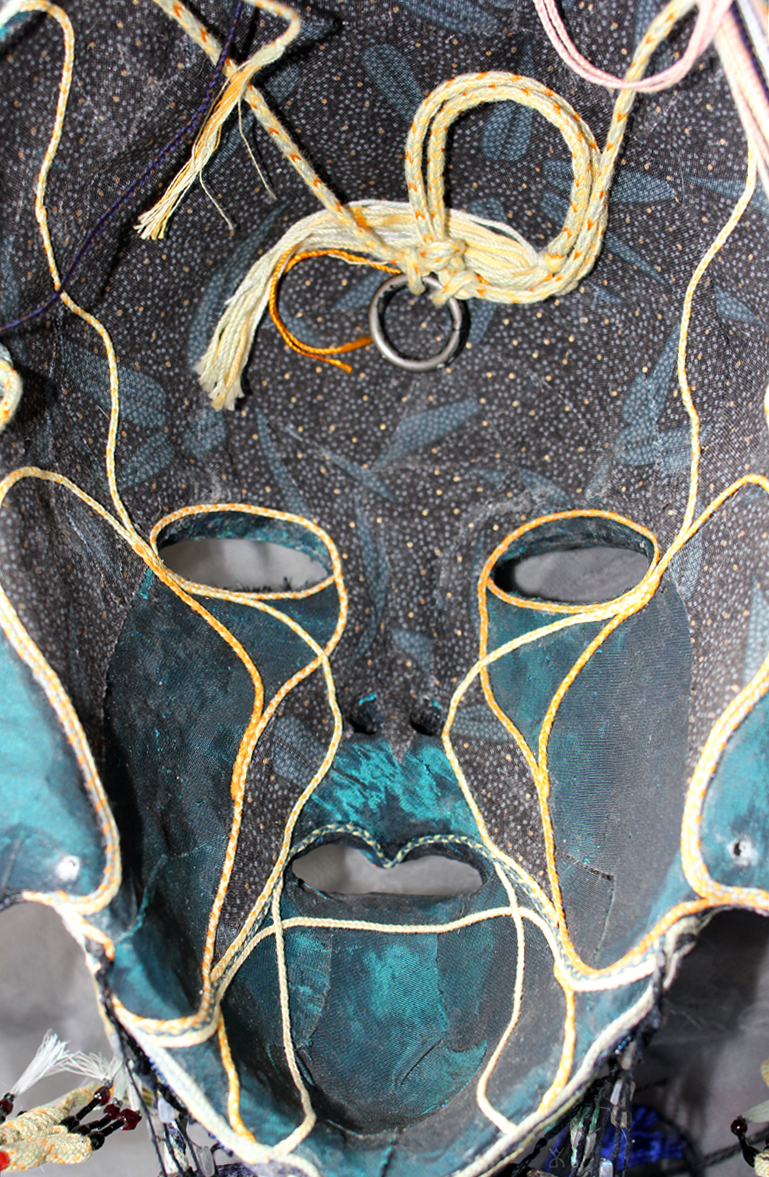 But then, I too, am a tool. It’s an exhilarating sensation to feel used and useful. To give into a long sustained seeping of inspiration from some place beyond my comprehension. Having abided with a large dose of uncertainty throughout the entire process of making a mask, the end result is always a surprise, in many ways only remotely resembling the initial sketches. All the tiny ‘choices’ made along the way seem as inconsequential as water in a creek ‘deciding’ to flow one way or another around a stone. Trusting in, and enjoying the journey, not fretting about the destination, seems to be the most natural way to carry on.
But then, I too, am a tool. It’s an exhilarating sensation to feel used and useful. To give into a long sustained seeping of inspiration from some place beyond my comprehension. Having abided with a large dose of uncertainty throughout the entire process of making a mask, the end result is always a surprise, in many ways only remotely resembling the initial sketches. All the tiny ‘choices’ made along the way seem as inconsequential as water in a creek ‘deciding’ to flow one way or another around a stone. Trusting in, and enjoying the journey, not fretting about the destination, seems to be the most natural way to carry on.